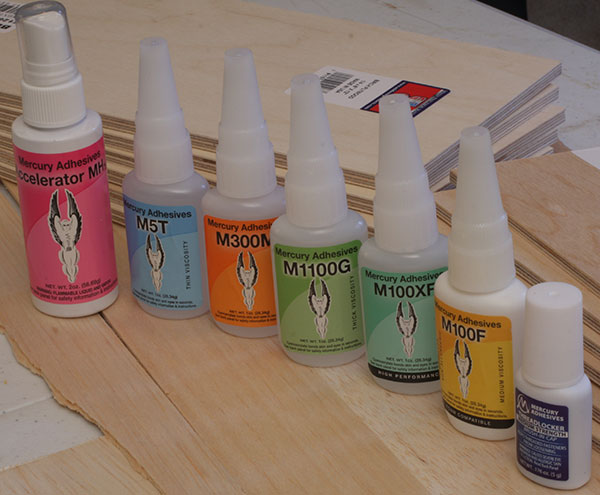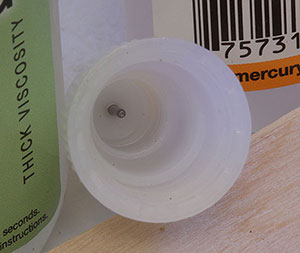



There is no shortage of adhesives that work on our models.
Text, photos and video by Tom Hintz
Posted – 3-7-2016
If you follow my web site, you know that I am deep into RC flying because I love it and because it does wonders for me in my fight against Alzheimer's. For the most part RC flying is a relaxing, occasionally a little too exciting and that is all fine with me and my neurologist. But there is are a few dark sides in this hobby, one being the ever-frustrating CA glue bottles.
On an episode of NCIS the character Tony was looking at a bottle of CA and asked how come the glue doesn’t stick to the bottle. Nice line for a TV program but the reality was that most CA glues seem to work best a sealing up the bottle they came in. The pop-on caps appear to be made of the material CA bonds with at a molecular level. The good news is that I can now say “most” CA bottles because the heavens have opened and the wizards at Mercury Adhesives have delivered unto us CA in bottles that don’t clog or let the CA inside go bad before we use up what we bought.
Not so oddly for something made correctly, Mercury Adhesives is an American company that actually makes their product in the United States. I’m sure that kind of corporate morality upsets the world economy in some way but it makes me giggle a little whenever I open one of their CA bottles – because I actually can open them and use the glue inside without having to go find a pliers and say things anybody with a sense of decency would not approve of.
While Mercury Adhesives bottles look fairly standard there is trickiness in the caps. Where others simply push on and pull off the Mercury Adhesives bottle caps screw on to insure a good seal. Plus, within the cap is a pin that goes into the spout to keep that open as the cap is screwed into place.
One of the things that surprised me the first time I opened a Mercury Adhesives bottle is that it is shipped ready to use. No poking a hole in a molded-shut spout, it’s already open. Mercury is that confident of the bottle. That means that if you screw the cap on snuggly it will always be like opening a new bottle of glue – until the glue is all used up. When is the last time you had to buy a new bottle of glue because the old one was empty rather than hopelessly sealed up trapping the remaining glue inside?
The world is full of “branded” adhesives labeled for everything from local hobby shops to the big kids on the Internet order block. The labels are different, what’s in them, very often not so much. Another common feature of branded anything is that it is meant to be a big mark profit point. Since many of these outlets are based on low price first the cost per unit is king, not the quality of what’s inside.
A pin in the cap appears to be why these
adhesives clog the bottle infrequently.
Mercury Adhesives products are ISO (International Organization for Standardization) certified which means they are designed and manufactured consistently and checked for quality. Mercury Adhesives also adds a serial number to each bottle so they can track each one of them to the batch they came from or to the person who did the chemistry to produce that batch. They also maintain samples of each batch for two years so they can go back and compare if need be down the road. Mercury Adhesives is so sure of their product that they offer a simple and powerful warranty. Their warranty is unconditional as they say in their literature, “No time frames or hoop jumping.” They simply stand behind their products.
Mercury Adhesives has the main three types of CA’s we are familiar with. The M5T (5 being the viscosity) is their thin CA, the M300M is the medium and M1100G is their thick or gap filling type. M100F and M1000F are their foam safe varieties that also produce a low “bloom” bond on plastics and such.
Then there is the M100XF that Mercury says it simply the best CA glue made using proprietary ingredients to produce a superior bond on a wide variety of materials. For our purposes here they mean wood, carbon and fabric type materials like glass cloth. There is something to be said about using all top shelf ingredients and virtually no fillers that many others use to “extend” the profit margin. That has been working because they add those fillers to the glues they package in bottles that kill the glue and/or our access to it before you can use all of it anyway. Some call the M100XF the “ARF glue” because it produces such solid joints and is perfect for going over all of the joints that you can reach in a new ARF before you start adding all of the components.
Naturally Mercury Adhesives has their own “kicker”. Their MH16 Activator/Accelerator (like I said, kicker) can be used with all of the Mercury Adhesive products. It is less aggressive than most kickers which produces a stronger bond.
It seems natural that Mercury Adhesives has their own thread locking compound also with a better way to apply it. Showing that they apply their brain power when it counts Mercury Adhesives calls their thread locking compound “Threadlocker” medium strength. To make sure people recognize this as the removable variety they make Threadlocker with a blue color as is common in the thread locker business.
Rather than apply the material straight from the nozzle which only works on fasteners below the bottle Mercury Adhesives packages their Threadlocker in a bottle with a small brush attached to the cap. That way you can apply as much of the material to the fastener as you want and you can do it at any angle above or below. I know this sounds like such a small thing, until you are faced with having to turn a big airplane over to treat threads that would otherwise be located above the bottle.
We might think that applying the superior Mercury Adhesives would require new techniques, never fear. The only potential difference in applying the Mercury Adhesives might be applying less of them. I did all the normal gluing balsa to balsa, balsa to plywood, plywood to balsa – all of the common joints in RC flying.
While I have been testing adhesives for woodworking for years trying to test them in RC flying needs a different point of focus because nearly any CA glue if applied within reason of the instructions will be stronger than balsa in terms of pure break strength. Perhaps our attention needs to be more on long term durability because of the vibration our glues are subjected to almost constantly. Just the fact that Mercury Adhesives are fresher and less contaminated should put them well ahead of the competition. I suspect that there is more in the US design and manufacturing that gives the Mercury Adhesives a major lead when we look at models staying together longer which translates into fewer crashes or damage from joint failure. The benefits of Mercury Adhesives stretch well into the future of the model.
If the only winning point in favor of the Mercury Adhesives would be the no clog, easy to seal bottles that lets us use all of the glue we pay for they would be a winner hands down. That is important to be sure but I think there is much more in the design and quality of the glue itself. While writing this review I have been going through the maiden process on my Top-Flite Giant Scale P47 Razorback. Part of my maidening process is checking for loose joints or broken parts. I had the misfortune of knocking a retract out of the wing when I whiffed on tightening an axle set screw. The box of Mercury Adhesives showed up on the day I had opened the wing to see all of the damage. I used lots of the M100XF on the thinner woods because everything I was working with is either part of the retract mount or it supports the mount. These are no-fooling-around joints and I needed them to stay put. Since doing the repair largely with the Mercury Adhesive I have put a bunch of flights on the Top-Flite Giant Scale P47 Razorback with nothing even acting like it wants to loosen up.
I thought the major surprises surrounding Mercury Adhesives had already revealed themselves to me but scary as it may sound, I was wrong again. The last part of my reviews is checking the street price on that day. I started comparing a 2oz bottle of the Mercury Adhesives M5T thin CA (Yes with the pin-in-cap) with other brands in the same size bottle, all on 3-3-2016.
The Mercury Adhesives M5T in the 2oz bottle sold for $7.49. The surprise came when I started looking at the bargain CA’s in 2oz bottles with many running $7.69, $9.92 up to $11.36 for a bargain brand that should be ashamed of themselves. This price anomaly means that Mercury Adhesives is looking to be fair in their pricing. Usually something made in the United States simply costs more. I understand some of the reasoning but not all. The folks at Mercury Adhesives are not only high level smart when it comes to designing and making CA glue they also decided to skip the greedy business plan and go for long term relationships with their customers. They certainly have converted me.
Visit the Mercury Adhesives web site – Click Here
Have a comment on this Review? –Email Me